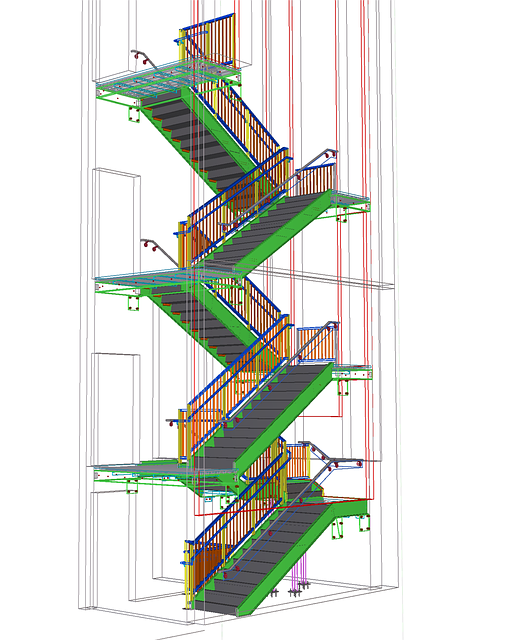Retrofitting older structures requires precise planning and structural CAD drafting for safe, efficient upgrades while preserving original design. Advanced software helps architects and engineers visualize, plan, and execute complex changes, ensuring structural integrity and regulatory compliance. This process begins with detailed building assessments, followed by digital modeling and strategic design to address weaknesses. Skilled contractors implement these plans, integrating modern materials while adhering to safety standards. Effective communication, accurate material specs, adequate funding, and flexibility are key to successful structural upgrades, leveraging structural CAD drafting for optimal results.
In today’s world, retrofitting and renovation are vital for enhancing building structures. This comprehensive article explores the intricate process of retrofitting and draftings, offering a detailed guide on upgrading aging infrastructure. We delve into the significance of structural CAD drafting in planning and executing successful retrofits, ensuring safety and longevity. From understanding the fundamentals to navigating challenges, this resource provides a step-by-step approach and best practices for stakeholders involved in these transformative projects.
Understanding Retrofitting and Renovation: A Comprehensive Overview
Retrofitting and renovation are crucial processes that transform existing structures into modern, safe, and efficient spaces. Retrofitting involves updating or replacing outdated elements in a building to enhance its performance and functionality while retaining its original design essence. This process is particularly essential for older structures where the initial construction methods might not meet today’s structural standards or code requirements.
Structural CAD drafting plays a pivotal role in this transformation. It provides precise, detailed technical drawings that guide renovation projects. Using advanced software, architects and engineers can meticulously plan and visualize the upgrades, ensuring every modification aligns with structural integrity and regulatory compliance. This comprehensive overview is vital for successful retrofitting, enabling informed decision-making throughout the renovation process.
The Role of Structural CAD Drafting in Upgrading Buildings
Structural CAD drafting plays a pivotal role in upgrading buildings, offering precise and detailed technical drawings that serve as the blueprint for renovations. It involves the skilled creation of 2D or 3D models using computer-aided design software, which allows architects and engineers to visualize and plan complex structural modifications. This process is crucial for retrofitting older structures, ensuring they meet modern safety standards and code requirements while preserving their historical integrity.
By leveraging structural CAD drafting, professionals can accurately assess the existing building’s condition, identify areas needing upgrades, and propose tailored solutions. These digital drawings facilitate informed decision-making, cost estimation, and project management. Moreover, they enable seamless communication among stakeholders, ensuring everyone involved understands the renovation scope, objectives, and potential challenges.
Step-by-Step Process for Successful Retrofitting Projects
Retrofitting and renovation for structural upgrades is a meticulous process that demands careful planning and execution. A successful project involves several key steps, each contributing to ensuring both safety and aesthetic enhancements.
The initial phase comprises thorough building assessment using structural CAD drafting to identify areas needing attention. This digital technology enables precise measurements and detailed analysis of existing structures, helping drafters create accurate plans for upgrades. Once identified, weaknesses or deficiencies are addressed in the design stage, incorporating modern materials and techniques while adhering to safety regulations. The final step involves meticulous implementation, employing experienced contractors who follow the approved blueprints, ensuring every detail aligns with the retrofitting goals.
Best Practices and Common Challenges in Structural Upgrades
Retrofitting and renovation for structural upgrades require careful planning and execution to ensure safety, durability, and compliance with modern standards. Best practices in structural CAD drafting involve thorough building assessments to identify load-bearing elements and potential weaknesses. Using advanced software tools, architects and engineers can create detailed digital models, facilitating precise modifications while minimizing waste and cost overruns. Regular communication among stakeholders—from clients to contractors—is vital for aligning expectations and addressing unique site conditions.
Despite these practices, common challenges include navigating complex building codes, especially in historic structures; unexpected structural issues discovered during renovation; and ensuring seamless integration of new components with existing architecture. Accurate material specifications and sourcing are also critical, as subpar materials can compromise the entire structure. Adequate funding and scheduling flexibility are essential to accommodate unforeseen complexities, allowing for a successful and safe structural upgrade process.
Retrofitting and renovation, guided by structural CAD drafting, offer a sustainable path toward modernizing buildings. By understanding the comprehensive process outlined in this article—from recognizing the need for upgrades to implementing best practices—professionals can successfully navigate these projects, ensuring both structural integrity and aesthetic enhancements. Structural CAD drafting serves as a powerful tool, enabling precise planning and accurate execution, ultimately fostering safer and more efficient living and working spaces.
